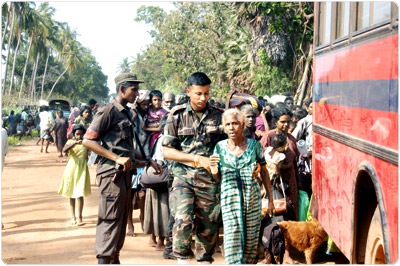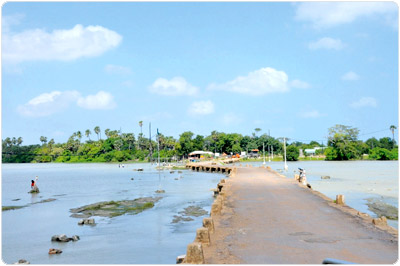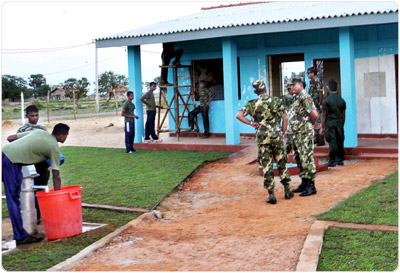Four years ago in Kilinochchi
By Dhaneshi Yatawara
 |
|
Vadduvakal Causeway
then - May 16, 2009 |
It was a totally different picture in
2009 and three years before that, in the main townships of the North and
the East. The air used to be filled with fear and uncertainty. Broken
damaged, abandoned houses without roofs, blasted water tanks, buildings
with explosives trapped, overgrown home gardens all gave a ghostly
feeling to these towns and villages.
Today there has been a total transformation. Amidst the numerous
allegations and obstructions this island nation walked far away from the
iron fist of terrorism clearing a path to bring the country to a better
position economically, socially and culturally. All the success was
carried on the shoulders of the valiant soldiers and admirably they
still have not put down their duties to rest.
The Sri Lankan security forces made supreme sacrifices in liberating
their motherland from the LTTE jackboot. Kilinochchi, the LTTE
headquarters was a ghostly town when the Sri Lanka Army troops of the 57
Division marched in January 2009 under the command of General Officer
Commanding Major General Jagath Dias. When the 58 Division under General
Officer Commanding Major General Shavendra Silva captured Paranthan as
we approached the dawn of 2009 it was almost a no man's land.
|

On the day people came in their thousands to the safety of the A
rmy in 2009 |
The LTTE pushed the escaping civilians more towards the eastern
coast. This silenced the artillery attack to the other side of the
Jaffna lagoon from Paranthan. Lead by Major General Kamal Gunarathne the
53 Division reached the Elephant Pass gateway to the Northern Peninsula
as year 2009 dawned and the 53 and 58 divisions were united.
There was no escape for the LTTE along the Eastern coast towards
North as troops of the 55 Division under the command of Major General
Prasanna de Silva who manned the eastern coast of the Jaffna Peninsula
bridging every lagoon on the way. This unity of Army troops was too much
for the LTTE to bear. With the rest of the Army troops strongly holding
the rescued grounds and forcing towards the LTTE from the south and
towards the east from the A9 road the LTTE was compelled to move into a
smaller area on the Puthumathalan coastal line.
On May 18, 2009 the country was waiting to hear the news of their
motherland regaining peace. On that day, Pudukuduyirippu became the
nerve centre for military operations and for the media.
The end of a ruthless terrorist outfit took place a few kilometres
away from the Pudukuduyirippu town. This, the final battle against
terrorism of the Eelam war IV is what became the turning point in the
history of this island nation. The situation of the enemy area came with
the help of aerial footage captured by the Sri Lanka Air Force. Blasts
in the enemy line were monitored as well as movements of terrorists and
their vehicles. The situation was becoming tense as the last terrorist
grouping on that land with their de facto leader and other top
terrorists were getting trapped within an area of a few square
kilometres.

Vadduvakal Causeway now

Soldiers putting the finishing touches to a new pre-school built
in Mullaitivu |
The only civilians in the area were the media crews waiting in front
of the Army operation room for situation updates. Residents in
Pudukuduyirippu and adjacent areas as well as civilians who were in the
no-fire zone all crossed the lines and reached safety away from the
terrorist iron fist.
On May 16 and 17 all the civilians who escaped the LTTE stronghold
were taken by the Government authorities to Vavuniya and sheltered in
the Welfare Centres for the Internally Displaced.
Today these people have returned home. Pudukuduyirippu as well as
other towns and villages have undergone a total change. Today, there are
no signs to prove that these towns and villages were the nerve centres
of the battle against terrorism.
There ended the sole responsibility of the Armed Forces to eliminate
terrorism from the motherland. Yet they never gave up and continue their
service to this day. Army personnel are involved in a large number of
development work such as agriculture, building roads and helping the
newly resettled communities.
The Sri Lanka Army has over 200,000 personnel who are paid by the
government and thus they feel duty bound to serve the country. The Army
shoulders not only the responsibility of uplifting the lives of
resettled communities, but also implementing major government programs
and even the preservation of archaeological sites, as the North and East
of Sri Lanka is filled with historical monuments.
Our soldiers are experts in the art of repairing and rebuilding as
they are the sons of the average villager. They are handy at work, and
mending a roof or rebuilding a wall is not a big deal for them. They
clean school buildings, repair community halls and kovils. The area is
dotted with Hindu temples and churches of different dimensions. Be it a
small kovil under a huge tree worshipped by a small village community or
a large multi coloured fascinating kovil in a more populated area all
are given equal consideration, protection and care. For the soldier it
is not the size of the kovil that matters but the belief of the common
man that needs to be respected.
First they made the land clear of landmines, AP mines and any other
booby traps laid by the LTTE. The gallantry on the part of the soldiers
is such that during the height of the war at the risk of their lives,
four man teams crawled to the other side of an LTTE bund for surprise
attacks in an area dotted with Anti Personnel mines. They overpowered
their sense of fear with courage and determination. They destroyed LTTE
terrorists and saved the innocent civilians.
The Government has already embarked on its plans for the rapid
development of these areas with much emphasis on infrastructure
developments. Though the Kilinochchi and Mullaitivu areas faced the most
fearsome and deadliest phase of the battle the development initiatives
are not lagging behind. Today the valiant soldiers are the driving force
behind the gigantic development drive launched by the government to
rebuild the war-ravaged North East to ensure a better life to the
community.
Yet, the threat remains though not on the Sri Lankan soil as certain
segments of the Tamil diaspora are forming groups to regain power, the
end of the Liberation Tigers of Tamil Ealam simply marks the beginning
of a new phase in their struggle for power. |


